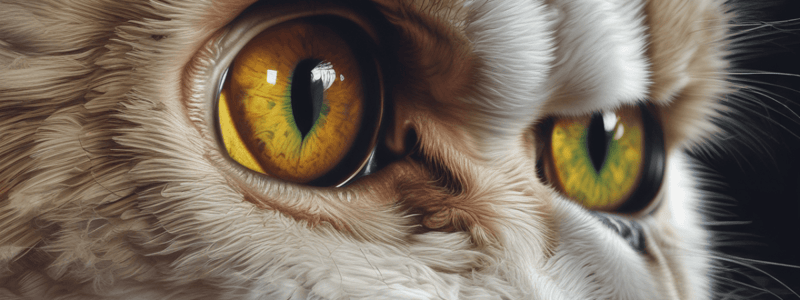Podcast
Questions and Answers
What is the current understanding of the mode of inheritance of nictitating membrane gland prolapse?
What is the current understanding of the mode of inheritance of nictitating membrane gland prolapse?
The mode of inheritance appears to be complex and potentially multigenic.
What is the proposed etiological mechanism of nictitating membrane gland prolapse related to connective tissue?
What is the proposed etiological mechanism of nictitating membrane gland prolapse related to connective tissue?
A weakness or laxity in the connective tissue anchoring the NMG to the periorbital tissues.
Why is it important to replace rather than excise the prolapsed nictitating membrane gland?
Why is it important to replace rather than excise the prolapsed nictitating membrane gland?
Because the gland contributes to tear production, especially in breeds predisposed to keratoconjunctivitis sicca.
What is the significance of the nictitating membrane in terms of physical protection and immune function?
What is the significance of the nictitating membrane in terms of physical protection and immune function?
What were the findings of Saito's study on the effects of third eyelid removal on lacrimation?
What were the findings of Saito's study on the effects of third eyelid removal on lacrimation?
What were the effects of third eyelid removal on the corneal epithelium, according to Saito's study?
What were the effects of third eyelid removal on the corneal epithelium, according to Saito's study?
What was the treatment used to successfully treat the conjunctivitis observed in the dog’s left eye within the first two weeks following nictitating gland surgery?
What was the treatment used to successfully treat the conjunctivitis observed in the dog’s left eye within the first two weeks following nictitating gland surgery?
What was the reason for aspiration of the fluid-filled mass on the left nictitating membrane?
What was the reason for aspiration of the fluid-filled mass on the left nictitating membrane?
What were the Schirmer tear test 1 readings in the right and left eyes, respectively?
What were the Schirmer tear test 1 readings in the right and left eyes, respectively?
What type of suture material was used in cases 1 and 2?
What type of suture material was used in cases 1 and 2?
What was the purpose of collecting fluid and submitting a piece of the wall of the mass in case 3?
What was the purpose of collecting fluid and submitting a piece of the wall of the mass in case 3?
What was observed upon eversion of the nictitating membrane?
What was observed upon eversion of the nictitating membrane?
What was the result of the fluorescein staining test?
What was the result of the fluorescein staining test?
What was the dosage of amoxicillin and clavulanic acid administered postoperatively in cases 1 and 2?
What was the dosage of amoxicillin and clavulanic acid administered postoperatively in cases 1 and 2?
What was the finding in the superonasal quadrant of the left eye based on slitlamp biomicroscopy?
What was the finding in the superonasal quadrant of the left eye based on slitlamp biomicroscopy?
What was the additional topical treatment used in case 2, besides tobramycin drops?
What was the additional topical treatment used in case 2, besides tobramycin drops?
Why was an Elizabethan collar used in each dog after surgery?
Why was an Elizabethan collar used in each dog after surgery?
What was the duration of postoperative medical treatment in cases 1 and 2?
What was the duration of postoperative medical treatment in cases 1 and 2?
What was the composition of the external layer of the cyst wall?
What was the composition of the external layer of the cyst wall?
What was present under the mucosa in the collagenic connective tissue?
What was present under the mucosa in the collagenic connective tissue?
What was the composition of the internal side of the cyst wall?
What was the composition of the internal side of the cyst wall?
What was the result of immunostaining for cytokeratin in the conjunctival and internal cyst linings as well as the lacrimal lobules?
What was the result of immunostaining for cytokeratin in the conjunctival and internal cyst linings as well as the lacrimal lobules?
What was the result of immunostaining for vimentin and α-smooth muscle actin?
What was the result of immunostaining for vimentin and α-smooth muscle actin?
What conclusion can be drawn from the microscopic findings?
What conclusion can be drawn from the microscopic findings?
What is the main concern in differentiating between conjunctival cysts and lacrimal gland cysts?
What is the main concern in differentiating between conjunctival cysts and lacrimal gland cysts?
What characteristic of conjunctival cysts distinguishes them from lacrimal gland cysts?
What characteristic of conjunctival cysts distinguishes them from lacrimal gland cysts?
What is the primary difference between dacryocoele and lacrimal gland cysts?
What is the primary difference between dacryocoele and lacrimal gland cysts?
What is the significance of the nictitating membrane gland in maintaining normal tear production?
What is the significance of the nictitating membrane gland in maintaining normal tear production?
What is the potential consequence of excising the lacrimal gland, as observed in the study?
What is the potential consequence of excising the lacrimal gland, as observed in the study?
What is the possible explanation for the decreased STT readings in the affected eyes of the first two cases?
What is the possible explanation for the decreased STT readings in the affected eyes of the first two cases?
Flashcards
Nictitating Membrane (Third Eyelid)
Nictitating Membrane (Third Eyelid)
The third eyelid, which is an important part of the eye's protective and immune functions.
Nictitating Membrane Gland Prolapse (PNMG)
Nictitating Membrane Gland Prolapse (PNMG)
A condition where the nictitating membrane gland protrudes from its normal position.
PNMG Surgery
PNMG Surgery
The surgical procedure to reposition the nictitating membrane gland.
Keratoconjunctivitis Sicca (KCS)
Keratoconjunctivitis Sicca (KCS)
Signup and view all the flashcards
Nictitating Membrane Gland (NMG)
Nictitating Membrane Gland (NMG)
Signup and view all the flashcards
Marsupialization
Marsupialization
Signup and view all the flashcards
Conjunctival Cyst
Conjunctival Cyst
Signup and view all the flashcards
Lacrimal Cyst
Lacrimal Cyst
Signup and view all the flashcards
Goblet Cell
Goblet Cell
Signup and view all the flashcards
Principal Lacrimal Gland
Principal Lacrimal Gland
Signup and view all the flashcards
Connective Tissue Laxity
Connective Tissue Laxity
Signup and view all the flashcards
Lymphoid Hyperplasia
Lymphoid Hyperplasia
Signup and view all the flashcards
Epithelial Lining
Epithelial Lining
Signup and view all the flashcards
Cytokeratin
Cytokeratin
Signup and view all the flashcards
Neutrophil
Neutrophil
Signup and view all the flashcards
Lymphocyte
Lymphocyte
Signup and view all the flashcards
Plasma Cell
Plasma Cell
Signup and view all the flashcards
Flattened Cell
Flattened Cell
Signup and view all the flashcards
Aspiration
Aspiration
Signup and view all the flashcards
Anti-inflammatory Treatment
Anti-inflammatory Treatment
Signup and view all the flashcards
Histology
Histology
Signup and view all the flashcards
Mucinous
Mucinous
Signup and view all the flashcards
Ductular Retention
Ductular Retention
Signup and view all the flashcards
Stratified Squamous Epithelium
Stratified Squamous Epithelium
Signup and view all the flashcards
Inflammatory Cell
Inflammatory Cell
Signup and view all the flashcards
Collagenic Connective Tissue
Collagenic Connective Tissue
Signup and view all the flashcards
Periorbital Tissues
Periorbital Tissues
Signup and view all the flashcards
Etiology
Etiology
Signup and view all the flashcards
Excision
Excision
Signup and view all the flashcards
Preservation
Preservation
Signup and view all the flashcards
Study Notes
Nictitating Membrane Gland Prolapse (PNMG)
- PNMG is a condition with a complex and potentially multigenic mode of inheritance, but the exact pathogenesis remains unclear.
- Several etiological mechanisms have been proposed, including weakness or laxity in the connective tissue anchoring the NMG to the periorbital tissues and lymphoid hyperplasia.
Surgical Treatment of PNMG
- Definitive treatment of PNMG is surgical, and prolapsed glands should be replaced rather than excised to preserve the gland's contribution to tear production.
- This is especially important in breeds prone to keratoconjunctivitis sicca.
Importance of the Nictitating Membrane
- The nictitating membrane provides physical protection of the cornea and is an important contributor to the secretory immune system.
- Removing the third eyelid can decrease lacrimation by 26% within 3-7 months, but values may recover to near normal after 1 year.
Case Study: Conjunctival Cyst Formation
- A dog developed a fluid-filled mass on the left nictitating membrane after PNMG surgery, which was aspirated monthly for 3 months with adjunctive anti-inflammatory treatment.
- Marsupialization was created by suturing the wall of the cyst to the adjacent NM conjunctiva, and the dog was discharged on the same day.
Histological Examination
- Tissue sections showed a thick collagenic connective tissue lined externally and internally by epithelial linings, with a dense infiltration by neutrophils, lymphocytes, and plasma cells.
- The internal side of the cyst wall was composed of a discrete lining of flattened cells, and the lining was positive for cytokeratin labeling.
Conjunctival Cysts vs. Lacrimal Cysts
- Conjunctival cysts are characterized by stratified squamous epithelium with possible goblet cells and a mucinous content.
- Lacrimal cysts can be differentiated by the presence of an epithelium lining and ductular retention.
Importance of the NMG in Tear Production
- The NMG is important in maintaining normal tear production, and its removal can lead to keratoconjunctivitis sicca.
- The principal lacrimal gland may be the main source of tears in some dogs, while the NMG is the primary source in others.
Studying That Suits You
Use AI to generate personalized quizzes and flashcards to suit your learning preferences.




